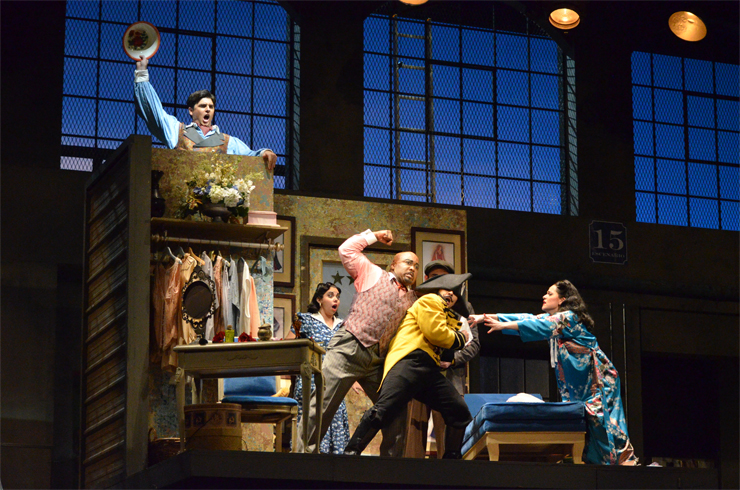
Florida Grand Opera's The Barber of Seville. Photo: Brittany Mazzurco Muscato for Florida Grand Opera
Anyone growing up in the 1950s and 60s will recognize Rossini's overture to The Barber of Seville as it underscored the Warner Bros. Looney Tunes theatrical cartoon short, Rabbit of Seville, featuring Bugs Bunny being chased by Elmer Fudd to operatic proportions on the stage of the Hollywood Bowl.
Perhaps director Dennis Garnhum took his cue from Bugs and set the Florida Grand Opera’s production of Barber’s buoyant arias and monkeyshines on a backlot of a 1940s movie studio. This production of The Barber of Seville kicked off FGO’s 75th anniversary season on Saturday, Nov. 14, at the Arsht Center in Miami. One of the characters in the stage action during the overture opened his lunch box, pulled out a large carrot with greens attached, and took a nice loud crunch. Homage paid.
French playwright Pierre Beaumarchais wrote a comic trilogy centering on the wily and resourceful character of Figaro. Both Mozart and Rossini worked with librettos based on Beaumarchais’s work, Rossini’s Il barbiere di Siviglia was lifted from the first play of the trilogy; Mozart’s Le nozze di Figaro from the second part.
Though rooted in comedy, Beaumarchais’s Figaro plays were thinly veiled criticisms of government and a satire on the aristocracy, and became somewhat of a lightning rod in the late 18th century political French climate. Perhaps it was one of the catalysts of the French Revolution a time for intellectual enlightenment, social justice and civil rights. Ironically, what was on the minds of the musicians and the audience this Saturday night was the horrific killings in Paris the night before, prompting FGO conductor Ramón Tebar to lead the orchestra in La Marseillaise, the French National Anthem, bringing the audience to their feet in a show of solidarity with the people of France.
What better way to combat tragedy than with comedy. The audience was ripe for such fare.
The disguises, mistaken identities and shenanigans of Rossini’s opera buffa have been amusing opera lovers for 200 years, and Garnhum has done a credible job placing the action on a movie studio backlot, complete with dressing rooms, props and costumes.
Of the two most famous barbers in all of musical theater, the dark side belongs to Sweeney Todd and the light side, to Figaro. Baritone David Pershall, a good looking, vibrant performer, fleshed out Figaro’s joie de vivre with antics, characterization and a matchless voice which delighted the audience all evening.
Rossini was the champion of a new style of opera which he called bel canto (beautiful singing) in contrast with the operatic styles of the Classical period. Bel canto is dazzling to audience and singers alike, marked by flowing vocal leaps in a single bound, luscious melodies with a mind-numbing array of notes in a single phrase. According to Rossini, it’s a style of music that requires a beautiful voice throughout the whole range, the mastery of a style that can’t be taught.
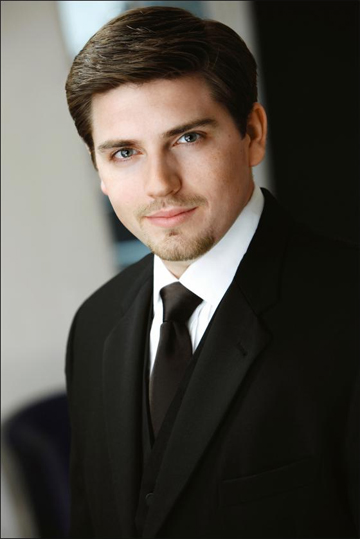
David Pershall
Pershall, with a gleaming smile, punctuated the rhythmic changes and embraced the songlike melody of Figaro’s instantly recognizable Largo al factotum della città. Singing of his many talents (doctor, barber, matchmaker), Pershall drew spurts of laughter from the audience as he trimmed and shaped the hair of a hastily conscripted gang of underemployed extras, miraculously changing one extra’s hair color twice! Pershall’s pipes were powerful and subtle at the same time, loading every la-la-la and Figaro-Figaro-Figaro with personality and precision, squeezing every bit of nuance out of this most famous of all arias. Pershall was sure-footed on the stage, which he commanded, striking a triumphant stance after nailing the aria’s ending, drawing howls from the audience.
Another crowd fave was bass Kevin Short, playing Dr. Bartolo, the powerful and suspicious studio owner planning to marry Rosina. Short, an elegant singer with a confident stage presence, is a physical actor whose expressions and characterizations matched his vocal prowess. Taking Rosina to task for trying to deceive him, Bartolo’s aria, A un dottor della mia sorte, requires the full command of its singer, and Short met this requirement in fine fettle. His highs and lows were of equal richness in tone, he nailed his money note, and crisply articulated all 189 mandatory rapid patter notes before the aria’s conclusion. He was an operatic force of nature.
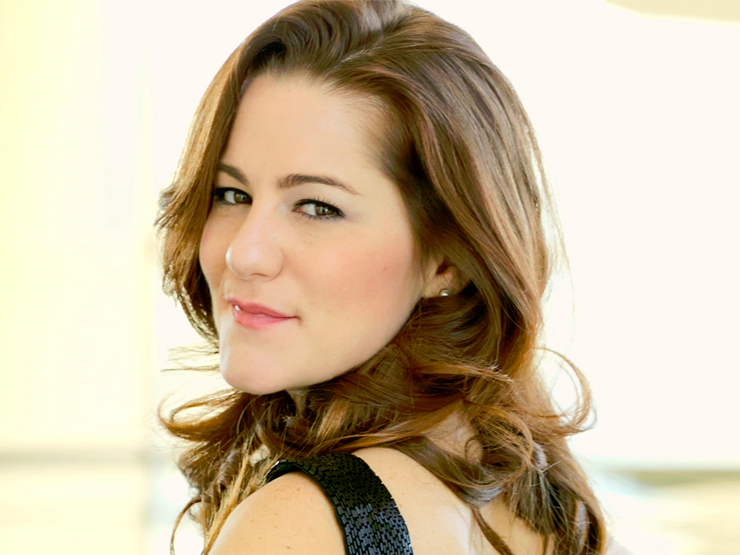
Megan Marino
Petite mezzo-soprano Megan Marino, playing Rosina, the wealthy starlet under the thumb of Bartolo, delivered her cavatina, Una voce poco fa, with Olympic size vocal cords. She adeptly handled the elaborate runs and cadenzas smoothly and easily as she mused on her love for the poor student, Lindoro (Count Almaviva). Super-perky, confident and mischievous, Marino drew the audience in as the bouncing portions of the music lifted up her voice, which then separated and lifted-off.
The handsome and energetic tenor Andrew Owens (Count Almaviva, disguised as the interloper, Lindoro), was a good match for Marino’s energy, but was more quality than quantity in voice. Though not a power tenor, while serenading Rosina, his runs on Ecco ridente in cielo were on point and clean, and the melodic passages to win Rosina’s affections on Se il mio nome saper voi bramate were pleasing, lyrical and honest. A solo classical Spanish guitar accompanying him on the latter aria was a lovely complement.
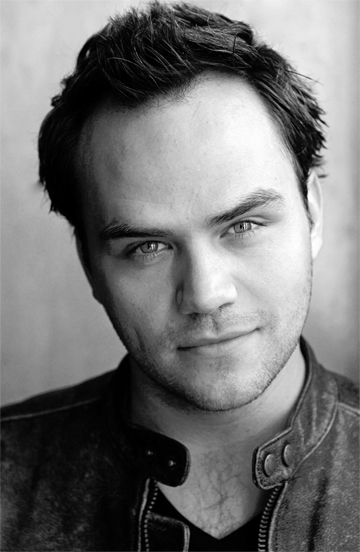
Andrew Owens
Bass Alex Soare, tall, lithe and thin, was refreshing in his characterization of the music coach and paparazzi, Don Basilio. His big instrument brought delicious slime to La calunnia è un venticello, encouraging Bartolo to smear Count Almaviva by spreading malicious gossip about him.
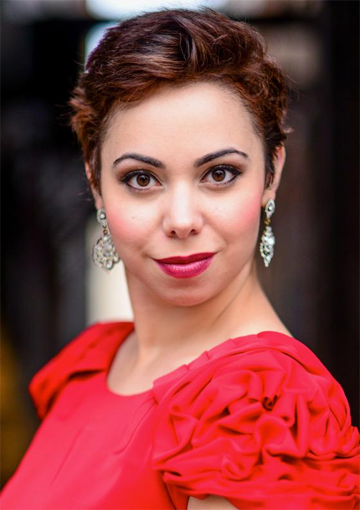
Eliza Bonet
Mezzo-soprano Eliza Bonet, playing Berta, was a vivacious presence with a voice to match, quick on her feet with terrific expressions that let you know exactly what she thought of both the shenanigans she aided and abetted and the abuse she endured. With a radiant face, Bonet mused vocally on Il vecchiotto cerca moglie, wondering why people act so crazy when they’re in love.
The duets, trios and ensemble pieces were great fun. The unison between Pershall and Owens was spot on in All'idea di quel metallo as the Count employed Figaro to help him connect with Rosina. Their recitative was crisp and the chemistry between the two men was palpable.
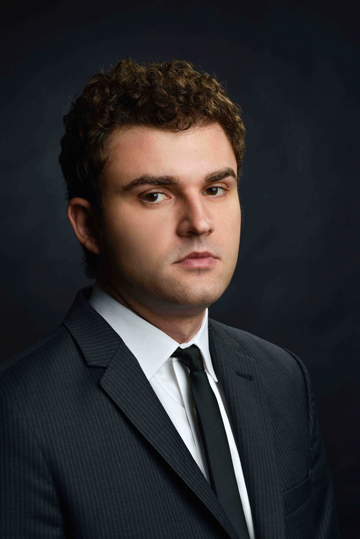
Alex Soare
Marino and Pershall traded runs on Dunque io son...tu non m'inganni? when Figaro suggested that Rosina write a letter of encouragement to the Count. Marino traversed her hallmark bel canto runs with aplomb.
A tidy trio between Figaro, Count and Rosina tickled the audience, the three voices harmonizing well as Figaro tossed flowers over the enamored couple, exhorting them to make a hasty exit before Bartolo and Basilio returned.
Rosina, Count, Basilio, Berta, Bartolo and Figaro (then tutti – everybody) joined forces on Fredda ed immobile, come una statua as Bartolo fought with the Count and the police entered the fray. The ensemble held together well through the group patter with beautifully blended harmonies through the chaos, music freely flowing from Rossini’s quill.
Remarking how Basilio looked ill, Figaro, Count, Rosina, Basilio and Bartolo teamed up for the rousing discussion on the quintet Don Basilio! – Cosa veggo!, their voices folding together charmingly.
Three supporting bassos were Nicholas Ward (Fiorello), Edgar Miguel Abréu (Ambrogio) and Zachary Elmassian (the imposing Officer).
FGO conductor, Ramón Tebar, reliably helmed this well-oiled orchestra, a classical guitar in the pit adding a Spanish vibe to the story.
Allan Stichbury’s set was a large space with signage indicating an out-of-view film sound stage complete with red lights that illuminated when actors went into it, ostensibly to film, and shut off upon their return. A two-level rotating unit provided a view of the exterior porch and exit stairs from Rosina's dressing room, and when rotated, shows the dressing room interior. Howard Tsvi Kaplan’s costumes were vivid, well made and colorful. The ladies gowns were sumptuous. The lighting by David Martin Jacques was clever, employing many stark and surprising effects that are seen in major contemporary theatrical productions.
The Barber of Seville
By Gioachino Rossini; libretto by Cesare Sterbini; conductor, Ramón Tebar; stage direction by Dennis Garnhum; associate director, Kathleen Stakenas; production, Vancouver Opera; sets by Allan Stichbury; lighting by David Martin Jacques; costumes by Howard Tsvi Kaplan; wig and makeup by Sue Schaefer; chorus master of "movie extras," Katherine Kozak; assistant conductor, Darwin Aquino; musical preparation by Sergio Puig; production stage manager, Liam Roche; projected English titles by Dennis Garnhum; projected Spanish titles by Dreambay Enterprises; supertitles operator, Karla Gutierrez; supernumeraries - Allen F. Bennett, Margie Elias Eisenberg, Juan Gamero, Humberto Gomez, Lucy Hynes, Bruce T. Jones, Lucia Minervini, Dr. Juan Pablo de Rivero Vaccari, Nicole Rose; adroit observations by Justin Moss.
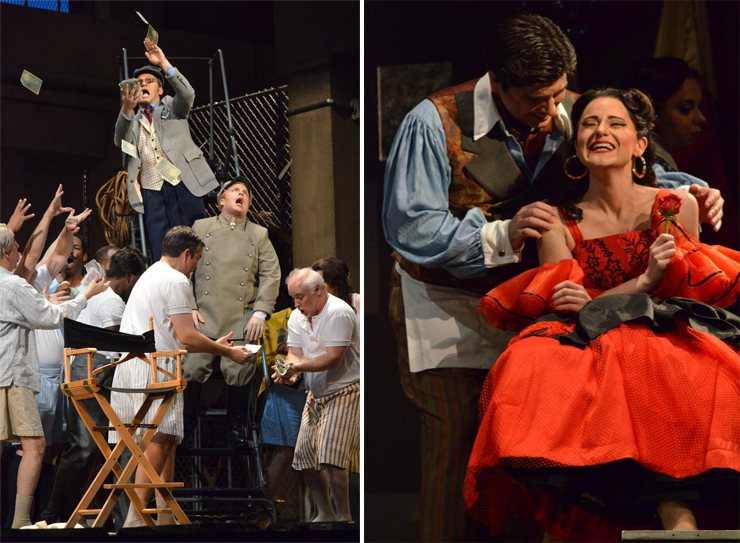
Florida Grand Opera's The Barber of Seville. Photo: Brittany Mazzurco Muscato for Florida Grand Opera
Cast:
- Rosina - Megan Marino (Nov 14, 17, 21) and Hilary Ginther (Nov 15, 20, Dec 3, 5),
- Count Almaviva - Andrew Owens,
- Figaro - David Pershall (Nov 14, 17, 21) and Brian James Myer (Nov 15, 20, Dec 3, 5),
- Dr. Bartolo - Kevin Short (Nov 14, 17, 21, Dec 5) and Kevin Glavin (Nov 15, 20, Dec 3),
- Don Basilio - Alex Soare,
- Berta - Eliza Bonet,
- Fiorello - Nicholas Ward,
- Ambrogio - Edgar Miguel Abréu and An Officer - Zachary Elmassian.
Schedule | The Barber of Seville.
Sung without amplification in Italian with projected translations in English and Spanish .
Miami - Adrienne Arsht Center / Ziff Ballet Opera House.
November 14, 15, 17, 20, 21, 2015.
Fort Lauderdale - Broward Center for the Performing Arts / Au-Rene Theater.
December 3, 5, 2015.
www.fgo.org.
 MAIN MENU
MAIN MENU

